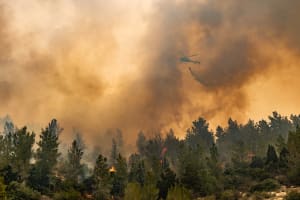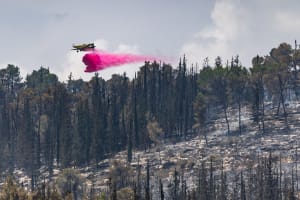The site where Jesus was baptized - Identifying biblical sites, Part 3
It is obvious to many archaeologists today that this complex on both sides of the river was a pilgrimage area already during the first centuries

A site of great importance in the Holy Land – sometimes referred to as Bethany Beyond the Jordan, Qasr el Yehud, Ainon (Enon or Aenon), or Bethabara – may indeed be known by many names but, in fact, refers almost to the same place. This site is associated with the tradition of three different biblical events, one of which is the baptism of Jesus Christ.
While minor controversies still exist today regarding the identification of this site, there is generally a broad consensus about it. In this case, traditions are strongly supported by archaeological evidence, the Bible, and other ancient texts.
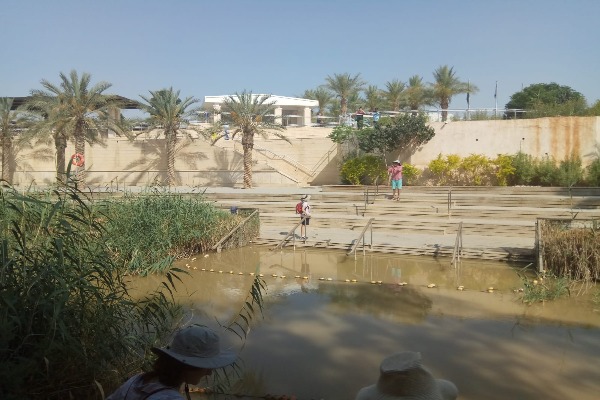
The question is: Where exactly was Jesus baptized along the Jordan River? At which specific site? Does it matter that much? And if so, should the location hold special significance?
Today, two different sites nearby are claimed to be the official location where John the Baptist conducted his ministry and baptized Jesus Christ just before the Messiah went to fast in the wilderness for 40 days. Both are located in the Jordan Valley: One is Bethany beyond the Jordan (called "Al-Maghtas" in Arabic, which means: "Baptism") on the eastern part of the Jordan River and into the modern Kingdom of Jordan. Just beyond it, on the western side of Israel is the site of "Qasr El Yehud." The meaning of this name in Arabic is literally, "Castle of the Jews," while some say it means "the crossing of the Jews."
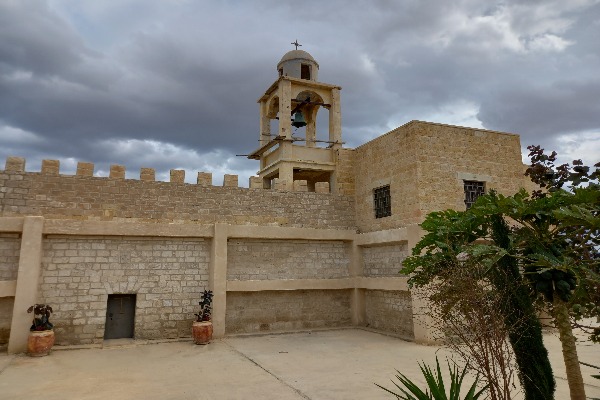
This name is one of those given to the Church of John the Baptist, which resembles a fortress and is situated hundreds of meters before the river. The label "fortress" is probably due to its impressive structure but also refers to the entire complex. The site is owned by the Greek Orthodox Church, which was constructed during the Byzantine period (probably in the late 5th or early 6th century). It enjoyed relative security and served as a guesthouse for pilgrims throughout history.
These two sites on both sides of the river should be seen, in fact, as one single site with different remains, separated by the river and the modern border between the Kingdom of Jordan and the State of Israel.
The baptismal sites on both sides of the river are considered to be the third holiest site in Christianity after the Church of the Nativity in Bethlehem and the Church of the Holy Sepulchre in Jerusalem.
They lie approximately 8.5 km (5.3 miles) north of where the river flows into the Dead Sea and about 9 km (about 5.5 miles) east of the center of Jericho.
Bethany Beyond the Jordan is called also Bethabara, but the Israeli western bank of the river should be considered part of Bethabara. It is important not to confuse Bethabara (also called "Bethany Beyond the Jordan") with Bethany, which is lcoated near the village of al-Eizariya on the Mount of Olives, where Jesus raised Lazarus from the dead.
In 2015, Bethany Beyond the Jordan was declared a UNESCO World Heritage Site within the Kingdom of Jordan.
The origin of the name Bethabara, derived from the Hebrew word "ma'abarot" (meaning crossings), connects to the tradition that it is near the site where the Israelites crossed the Jordan River into the land of Israel mentioned in Joshua 3 and 4.
The location by name is first mentioned in the Book of Judges: "And Gideon sent messengers throughout all mount Ephraim, saying, Come down against the Midianites, and take before them the waters unto Bethbarah and Jordan. Then all the men of Ephraim gathered themselves together, and took the waters unto Bethbarah and Jordan." (Judges 7:24, KJV)
Because of the analogy in Christianity between Elijah and John the Baptist, many identify Bethabara with the place near the Jordan where Elijah ascended to heaven, as mentioned in 2 Kings 2:7-8, 11. However, there is no archaeological or written proof for this identification.
The tradition that John the Baptist baptized his followers and Jesus at this location is supported by the Gospel of John: "These things were done in Bethabara beyond Jordan, where John was baptizing." (John 1:28, KJV)
Later in the Gospels, it is mentioned as the place where Jesus returned: "And went away again beyond Jordan into the place where John at first baptized; and there he abode." (John 10:40, KJV)
On the 6th-century Madaba Map mosaic, two sites appear facing each other on both sides of the river. On the eastern bank (above the river, as shown on the map), the inscription reads: "Ainon, where now is Sapsafas."
The name "Ainon" is a corruption of the Hebrew word "Ain" (meaning spring), while "Sapsafas" (Σαπσαφάς) was the ancient name of Wadi al-Kharrar, the eastern tributary of the Jordan River that flows into it at this location.
On the western bank (below the river, as shown on the map), at what is now Qasr al-Yahud, the original Greek name "Βέθαβαρά" (Bethabara) is noted with the inscription: "Bethabara, the place of the baptism of Saint John."
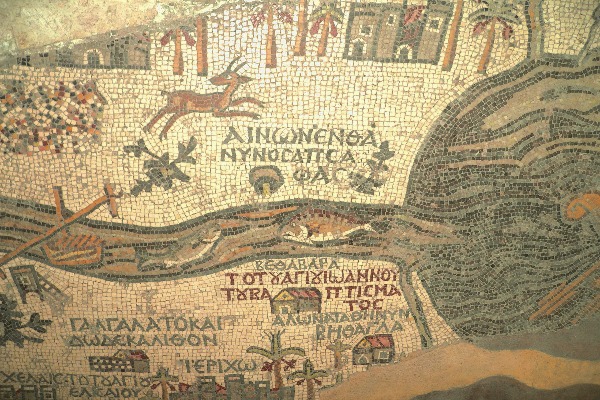
The name "Bethabara" later evolved into "Bethany," as reflected in the Greek New Testament. Origen, writing in the early 3rd century A.D., pointed out that this Bethany is distinct from the Bethany on the Mount of Olives, as it is located beyond the Jordan.
Bethabara's precise location, where John the Baptist baptized Jesus and his followers, has been the subject of extensive research. The Gospel of Matthew suggests that the site of Jesus was baptized near Jericho, while, in another verse, the Gospel of John implies that a baptismal site used by John was within a day's walk from Cana in Galilee and two to three days from Jerusalem: "And John also was baptizing in Aenon near to Salim..." (John 3:23, KJV)
This places the baptismal site (or another one) further north, possibly near Tel Shalem, located south of modern Tirat Zvi. A 4th-century A.D. pilgrim and a 6th-century traveler noted that the historical baptism site was five miles north of the Dead Sea, with the hill from which Elijah ascended to heaven located to its east.
This pilgrim also described protective measures taken to shield the Byzantine church from flooding during the reign of Emperor Anastasius I (491-518). The pilgrims mentioned a cross-bearing pole in the middle of the river to mark the place of Jesus' baptism.
A third traveler, the anonymous pilgrim of Piacenza, wrote in 570 that the historical baptism site was opposite the Church of John the Baptist (the one located at Qasr al-Yahud on the river's western bank).
Today, most scholars refer to the account of the pilgrim of Piacenza as the accurate identification for the baptismal site of Jesus Christ.
In 1899, the first archaeological finds were discovered on the eastern bank of the Jordan River, at Bethany Beyond the Jordan (of today's Kingdom of Jordan). However, it was only after the 1994 Israel-Jordan peace treaty, and the clearing of landmines near the border, that the remains of ancient churches, caves, and several baptismal pools were uncovered. All were dated to the Byzantine period and even earlier.
It is obvious to many archaeologists today that this complex on both sides of the river was a pilgrimage area already during the first centuries. The discovery of numerous 1st-century pottery shards and debris from cooking pots on the ground supports the high frequency of visits to the site. It has also been documented that significant buildings were constructed during the Byzantine period at this location for worship and commemoration.
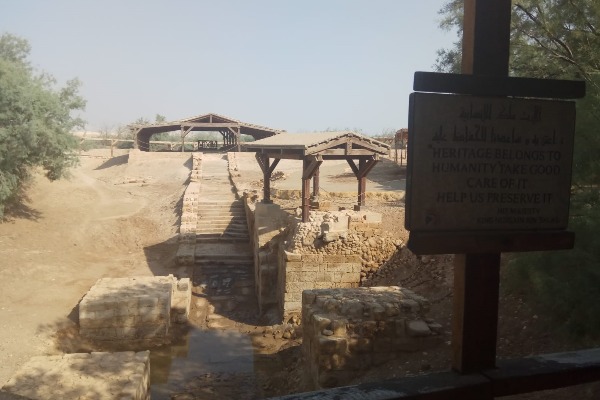
After extensive debates, many scholars accepted the theory that Bethany beyond the Jordan (Al Maghtas), or Bethabara, together with Qasr El Yehud (also called Bethabara, according to the Madaba Map) is, indeed, the site where Jesus was baptized.
It is more than accurate to believe that the Gospels of John and Matthew refer to the same location for the baptism of Jesus Christ, as written in Matthew 3:13-16, John 1:28 and John 10:40. It could be that the mention of John the Baptist being at Aenon near to Salim mentioned in John 3:23 is another northern location near Tel Shalem, used by John the Baptist on occasion for other baptisms and erroneously mentioned on the Madaba map, on the eastern side of the river, in front of Bethabara and near it.
Alternatively, since "Ainon" may originate from the Hebrew word "Ain" (spring) the "Ainon of Sapsafas" mentioned in the Madaba Map may be another "Ainon" different from the northern Aenon near Salim (Shalem). This option is most likely the more accurate of the two.
The location of Al Maghtas and Qasr El Yehud as being the true place for the historical baptism of Jesus Christ makes even more sense because its location is just in front of Jericho to the west. Indeed, in Matthew 3:13-16, Jesus is baptized, and in the following chapter, he is already going to fast in the wilderness, which should be located above Jericho, according to an ancient tradition.
The tradition that the Israelites crossed at the same location is quite logical: They came from the area of Shittim (and from the Mount Nebo area before it) and reached the land of Jericho to begin their conquest. Because Nebo and Shittim are directly across the valley and the river from Jericho, it follows that the crossing would have occurred at this central location – in the middle.
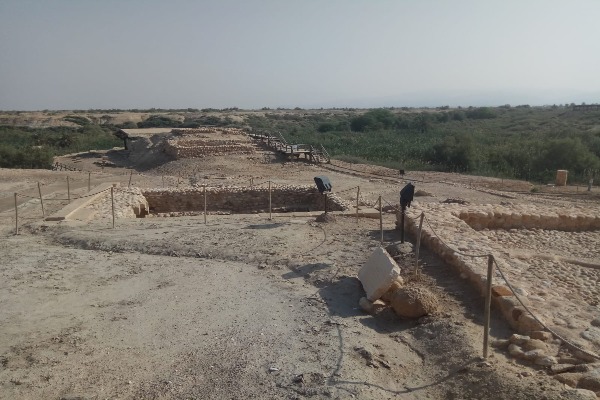
Throughout history, from the Byzantine period and later until the British Mandate beginning in 1923, monasteries and guesthouses were built along the western bank of the Jordan River for pilgrims who were coming to be baptized at the site. The abundance of monasteries in the area earned it the nickname "Land of Monasteries" today.
The three different biblical events that likely occurred at this same spot may be spiritually interconnected.
Some scholars view the crossing of the river by the Israelites as a foreshadowing of Jesus’ baptism, or as a symbolic entry of Jesus into His ministry, similar to how the Israelites entered the Promised Land.
The tradition of Elijah's ascension at this location is seen as a precursor to Christ’s future ascension. Additionally, the double portion of anointing given to Elisha, Elijah’s disciple, can be seen as a foreshadowing of the Holy Spirit that Christ gave to the Church after His return to heaven.
If so, these two Old Covenant events, foreshadowing distinct events in the life of Christ on earth, serve as the Old Testament's way of marking the timeline for Jesus's first coming: the beginning with His baptism and the end with His ascension.
In summary, Bethabara may be the same name given for both sides of the Jordan River baptismal historical sites of Al Maghtas and Qasr El Yehud, but mainly for the eastern side.
Bethany Beyond the Jordan is most probably the El Maghtas site, according to the archaeology and the Gospel. Aenon near Salim (or Shalem) should be located somewhere else in the north. The late 6th century A.D. Madaba map is likely presenting probably another "Ainon", an "Ain" (spring) named "Sapsafas."

Aaron Goel-Angot is a Belgian-Israeli archaeologist with an expertise in antiquities identification. He is an enthusiastic numismatist and a licensed tour guide. He holds a BA degree in archaeology from the Institute of Archaeology at the Hebrew University of Jerusalem. He joined the ALL ISRAEL NEWS team as an Archaeology and Tourism correspondent. Aaron is married, father of three young children and lives in Jerusalem.
You might also like to read this:








